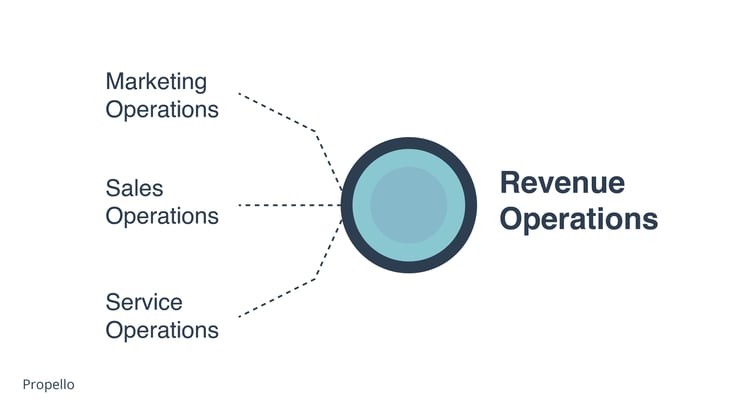Did you know that according to Spiceworks, 56% of companies that have implemented RevOps and aligned their teams are confident of far exceeding their revenue goals? If you're looking for ways to streamline your revenue operations and maximize growth, RevOps could be the answer.
RevOps takes a holistic approach by bringing together your sales, marketing, and customer success teams to align their goals, processes, and technologies. By breaking down the traditional silos that often hinder collaboration and efficiency, RevOps enables you to achieve better alignment, improve collaboration, and ultimately drive increased revenue.
Implementing a successful RevOps strategy requires careful planning and execution. It involves assessing your current operations, identifying areas for improvement, and implementing a framework that fosters collaboration and alignment across departments.
In this article, we will explore the key steps and best practices to help you implement a successful RevOps strategy in your organization. So, if you're ready to revolutionize your revenue operations and unlock your full growth potential, read on to discover how RevOps can transform your business.
| What Is RevOps Revenue operations (RevOps) is a method to better align organizations based on strategy, process, workflow, data, analysis, and technology. |
What is Revenue Operations (RevOps)?
Revenue Operations, commonly referred to as RevOps, is a strategic approach that aligns sales, marketing, and customer success teams to drive revenue growth and improve business performance. It involves integrating processes, data, and technology across these departments to create a unified revenue engine.
At its core, RevOps focuses on breaking down departmental silos and fostering collaboration among teams responsible for revenue generation. By aligning strategies, goals, and metrics, RevOps enables organizations to streamline operations, enhance customer experiences, and drive sustainable revenue growth.
RevOps goes beyond traditional departmental structures and brings a holistic view to revenue generation. It recognizes that sales, marketing, and customer success teams are interconnected and depend on each other's success to achieve overall revenue targets.
By aligning these teams, organizations can optimize the customer journey, improve operational efficiency, and accelerate revenue growth.
In the RevOps model, teams work collaboratively, sharing insights, data, and feedback to drive revenue outcomes. This collaborative approach breaks down communication barriers and fosters a culture of shared responsibility for revenue performance.
RevOps enables teams to leverage data-driven insights, identify bottlenecks in the revenue process, and implement improvements to enhance overall performance.

Key Components of RevOps
To implement a successful RevOps strategy, it's important to understand the key components that drive its effectiveness. These components include:
-
Process Integration: RevOps involves integrating sales, marketing, and customer success processes to create a seamless customer journey. This integration ensures that all teams are aligned in their efforts to attract, engage, and retain customers.
-
Data Integration: Centralizing and integrating data from different departments and systems is crucial for RevOps success. It enables teams to have a comprehensive view of customers, identify patterns and trends, and make data-driven decisions.
-
Technology Enablement: Leveraging technology solutions, such as CRM platforms, marketing automation tools, and analytics software, is essential for RevOps implementation. These tools enable teams to streamline processes, automate tasks, and gain actionable insights.
-
Metrics and KPIs: Defining and tracking key performance indicators (KPIs) and metrics is crucial for measuring the success of a RevOps strategy. These metrics should align with revenue goals and provide visibility into the effectiveness of sales, marketing, and customer success efforts.
-
Collaboration and Communication: Effective collaboration and communication are fundamental to RevOps. Teams must work together, share insights, and align their efforts to achieve revenue objectives. Regular meetings, cross-functional collaboration, and open communication channels are essential for success.
By implementing these key components, organizations can establish a strong RevOps foundation and create an environment conducive to revenue growth. RevOps provides a framework that brings departments together, ensures alignment, and empowers teams to drive revenue outcomes.
Benefits of RevOps Work
According to Super Office, over 67% of consumers now prefer to navigate the sales cycle independently. This shift in consumer behavior necessitates a change in the way we sell.
RevOps has gained significant traction in recent years because it offers several compelling benefits for organizations.
Here are the key reasons why RevOps works:
1. Improved Alignment
RevOps breaks down the silos between sales, marketing, and customer success teams, fostering collaboration and alignment. By aligning strategies, goals, and metrics, RevOps ensures that all departments work towards a common objective: revenue growth.
This alignment eliminates conflicts, improves communication, and enhances overall operational efficiency.
2. Enhanced Customer Experience
With RevOps, organizations can deliver a seamless and consistent customer experience throughout the entire customer journey. By integrating processes and data, RevOps enables teams to gain a comprehensive understanding of customers, anticipate their needs, and deliver personalized interactions.
This results in improved customer satisfaction, loyalty, and ultimately, higher revenue.
3. Data-Driven Decision Making
RevOps relies on data integration and analysis to drive decision-making. By centralizing and analyzing data from various sources, organizations can gain valuable insights into customer behavior, preferences, and buying patterns.
These insights enable teams to make informed decisions, optimize strategies, and identify opportunities for revenue growth.
4. Operational Efficiency
RevOps eliminates redundant processes, automates tasks, and streamlines operations. By leveraging technology and standardizing workflows, organizations can improve efficiency, reduce manual efforts, and optimize resource allocation.
This allows teams to focus on revenue-generating activities and drive better results.
5. Scalability and Growth
RevOps provides a scalable framework for revenue growth. By aligning teams, processes, and technology, organizations can scale their operations without sacrificing efficiency.
RevOps enables companies to adapt to changing market dynamics, expand into new markets, and seize growth opportunities while maintaining a strong revenue engine.
6. Measurement and Accountability
RevOps emphasizes the use of metrics and KPIs to measure performance and drive accountability. By defining clear metrics and aligning them with revenue objectives, organizations can track progress, identify areas for improvement, and hold teams accountable for their contributions to revenue growth.
This enables continuous optimization and drives a culture of performance.
Aligning Sales, Marketing, and Customer Success
One of the key pillars of a successful RevOps strategy is aligning sales, marketing, and customer success teams. By fostering collaboration and communication, you can create a unified revenue engine that drives customer acquisition, engagement, and retention.
According to a report by Aberdeen Group, companies with strong alignment between sales and marketing achieve an average of 32% annual growth in revenue.
To align your teams effectively
- Establish shared goals and metrics for revenue generation
- Develop a culture of transparency and collaboration, where sales, marketing, and customer success teams work together to achieve common objectives.
- Implement regular cross-functional meetings and communication channels to foster information sharing and feedback loops.
Implementing a Revenue Operations Framework
Implementing a revenue operations framework is a crucial step in driving alignment and optimizing your organization's revenue generation efforts. By bringing together sales, marketing, and customer success under one unified RevOps strategy, you can enhance efficiency, improve collaboration, and ultimately drive revenue growth.
Here are key steps to successfully implement a revenue operations framework:
1. Sales Enablement and Training
Sales enablement plays a vital role in a successful RevOps strategy. Provide comprehensive sales training and onboarding programs to equip your sales team with the necessary skills, product knowledge, and sales techniques.
Ensure they have access to the right tools and resources to effectively engage with prospects and close deals. A survey by CSO Insights found that companies with a formal sales enablement program achieved a 15.3% increase in win rates compared to companies without a sales enablement program.
2. Marketing Alignment and Demand Generation
In a successful RevOps strategy, marketing plays a critical role in driving demand generation and supporting the sales process. Collaborate closely with your marketing team to create aligned strategies and campaigns that target your ideal customers.
Implement integrated marketing automation systems to streamline lead generation, nurturing, and scoring processes. According to Inside View, organizations that align their sales and marketing functions achieve a 36% higher customer retention rate.
3. Customer Success and Retention
Customer success is a critical component of a successful RevOps strategy. Establish proactive customer success processes that focus on delivering value and ensuring customer satisfaction.
Implement customer success metrics and feedback mechanisms to track and measure customer engagement, retention, and loyalty.
To drive customer success, collaborate closely with your customer success team to align their efforts with sales and marketing strategies. Facilitate knowledge transfer between departments to ensure a seamless transition from the sales process to customer onboarding and support.
Leverage customer feedback to continuously improve your sales and marketing initiatives and address any pain points or challenges customers may face.
4. Technology and Automation
Technology plays a vital role in a successful RevOps strategy. Evaluate and select the right technology stack that supports your RevOps framework and enables seamless collaboration across teams.
Automate repetitive tasks and workflows to improve efficiency and free up time for strategic activities. Leverage analytics and reporting tools to gain data-driven insights into revenue performance, customer behavior, and market trends.
Integrating your RevOps technology stack with customer relationship management (CRM) systems is crucial for a unified view of customer data. It enables personalized interactions, targeted marketing campaigns, and effective customer relationship management.
According to a study by Nucleus Research, organizations that integrate their CRM systems with other sales and marketing technologies achieve a 14.6% increase in sales productivity.
5. Continuous Improvement and Iterative Refinement
Implementing a successful RevOps strategy requires a culture of continuous improvement and iterative refinement. Monitor and analyze performance metrics to identify areas for optimization and enhancement.
Gather feedback from stakeholders, including sales, marketing, and customer success teams, to understand their pain points and gather insights for improvement. According to a report by McKinsey & Company, companies that embrace a culture of continuous improvement achieve a 10% increase in revenue.
Make data-driven adjustments to your RevOps strategy based on insights gathered from performance metrics and stakeholder feedback. Continuously evaluate and refine your processes, workflows, and technology stack to align with evolving market dynamics and customer expectations.
6. Case Studies and Success Stories
Real-world examples of successful RevOps implementations serve as valuable sources of insights and inspiration for shaping your own strategy. By examining case studies and success stories, you can gain a deeper understanding of how organizations have overcome challenges, implemented RevOps approaches, and achieved remarkable outcomes.
These examples highlight the practical application of RevOps principles and provide a roadmap for success. Extracting key learnings and best practices from these case studies and success stories empowers you to apply their strategies to your own RevOps journey.
By learning from the experiences of others, you can avoid common pitfalls, leverage proven strategies, and tailor them to suit your organization's specific needs. Case studies and success stories serve as valuable benchmarks for evaluating your progress and refining your RevOps strategy.
They provide inspiration, guidance, and practical insights that can propel your organization toward achieving remarkable outcomes.
Challenges and Mitigation Strategies
Implementing a successful revenue operations (RevOps) strategy is not without its challenges. However, by identifying these challenges and implementing effective mitigation strategies, you can overcome obstacles and ensure the smooth execution of your RevOps initiatives.
Here are key challenges you may encounter and strategies to mitigate them:
1. Resistance to Change
Resistance to change is a common challenge when implementing RevOps. To address this, foster a culture of open communication and transparency.
Clearly communicate the benefits of RevOps to all stakeholders and involve them in the decision-making process. Provide training and resources to help teams adapt to new processes and emphasize the positive impact on their day-to-day work.
2. Organizational Silos
Silos within the organization can hinder the success of RevOps. Break down these silos by promoting cross-functional collaboration and creating shared goals and incentives.
Encourage regular meetings and collaboration sessions between sales, marketing, and customer success teams to foster a unified approach and ensure everyone is working towards common objectives.
3. Data Integration Complexities
Integrating data from various systems can be a complex task. Invest in the right technology infrastructure, such as a robust customer relationship management (CRM) system and data integration tools, to ensure seamless data flow across departments.
Establish data governance practices to maintain data accuracy and consistency.
4. Ensuring Ongoing Support and Adaptability
RevOps requires ongoing support and adaptability to stay effective. Provide comprehensive training and support to all teams involved in RevOps.
Offer regular workshops and educational resources to keep everyone up to date with best practices and industry trends. Stay agile and adaptable to changes in the market and customer expectations by continuously evaluating and refining your RevOps strategies.
By addressing these challenges head-on and implementing effective mitigation strategies, you can overcome obstacles and ensure the success of your RevOps strategy. Remember that RevOps is a continuous journey of improvement, so stay committed to ongoing communication, collaboration, and adapting to evolving business needs.
Implement Your RevOps Strategy
Revenue operations act as a bridge connecting your marketing operations, sales ops, customer success ops, and even product ops. It connects the dots between those revenue-facing departments into a unified view and gets everyone on board with a common goal.
Instead of working independently and keeping important data to themselves, everyone collaboratively works toward a common goal, sharing knowledge freely.
As a marketing professional, embracing the RevOps approach empowers you to play a pivotal role in revenue generation and organizational success. By continuously refining your processes, you can optimize revenue generation, improve customer experiences, and achieve sustainable growth.
Now, armed with the insights and best practices shared in this article, it's time to take action and implement a successful RevOps strategy in your organization. At Fine Media, we help your business implement RevOps by developing strategies that fit your business, and training where necessary.
Contact us today to learn how we can help your organization achieve its goals.



